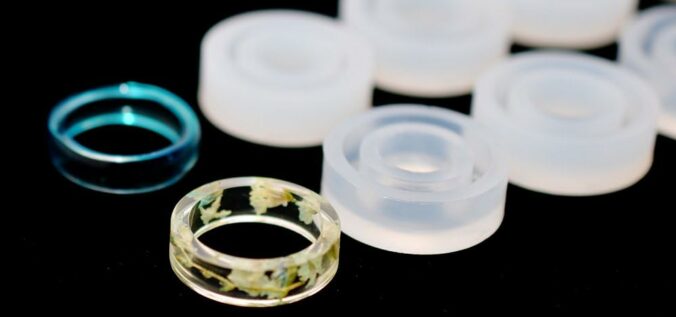Introduction
In our seventh session, we will begin our work with silicone moulds by creating a mould of the 3D printing ring you made earlier in the course. Next class, we will use the silicone ring mould you created today to make an epoxy resin cast of your ring.
Silicone moulding is a versatile technique used in various industries for creating detailed and intricate objects through the use of silicone rubber moulds. The process involves creating a mould from an original object and then using the mould to reproduce multiple copies of the original item. Some types of projects you can make with silicone moulding include: jewelry, figurines, baking model making, and Industrial Parts and Components.
Learning Objectives
- Describe the basic principles and techniques of silicone mould making
- Identify the appropriate materials and tools for a small silicone mould
- Use appropriate safety and hygiene when working with silicone
- Prepare your 3D-printed ring to make a silicone mould of it.
- Design and create a simple one-part silicone mould for your 3D-printed ring
- Troubleshoot and solve common problems that sometimes come up during the mould-making process
Pre-class Activities (15 min)
Please prepare for our hands-on in-class activities by watching the following video and reading the article below:
This video shows us how to make a Silicone Ring Mold and then pour the epoxy resin into the mould. We will be covering epoxy resin next class, so you really only need to watch the first 3-minutes of the video this week (Note: the quality of the video isn’t great, but the content is excellent):
Please read the following short article that has answers to the most frequently asked questions about silicone moulds and then the Silicone Moulding Guide with 3D Printed Masters tutorial:
Class Time (30 min)
- Class Check-in & Q&A
- Use cases for silicone moulds
- Review safety & key skills
Hands-on Lab Time: Silicone Moulding (60 min)
Work through the first two pages of the DSC Making Silicone Moulds guide to make a mould of your 3D-printed ring.
NOTE: Just a reminder that next week we will be creating an epoxy resin, so please make sure to use the provided safety equipment:
- Safety glasses
- Latex gloves
- N95 mask for Epoxy Resin work next class (we will be in a well-ventilated area)
Hands-on Lab Time: Other Projects -or- IoT Driver Install (60 min)
- Work on other projects
-or- - Prepare for IoT next class by installing the necessary drivers on your laptop
Critical Reflection (20 min)
- Blog about the following (including one or more pictures and/or videos):
- Your experience making a silicon mould
- Are there any other silicon mould projects that look interesting to you?
- Continue brainstorming ideas for your major project (no decision on your final project need to be made at this time, and you may decide to do something else later in the course)
References
AldaxMoulds (Director). (2010, February 7). How to Make a Silicone Ring Mould. https://www.youtube.com/watch?v=9q1HC4yECnk
Emily, A. (2022, December 16). Frequently Asked Questions » Silicone Mould Addicts. Silicone Mould Addicts. https://siliconemouldaddicts.com/frequently-asked-questions/
Hartman, V. (2023, March). DSC Staff Guide: Resin mould casting. Google Docs. https://docs.google.com/document/d/1ZyIZlGb38ZFHc2KrBxLACYqMtA-oNU2IbDlHQVyVW90/
